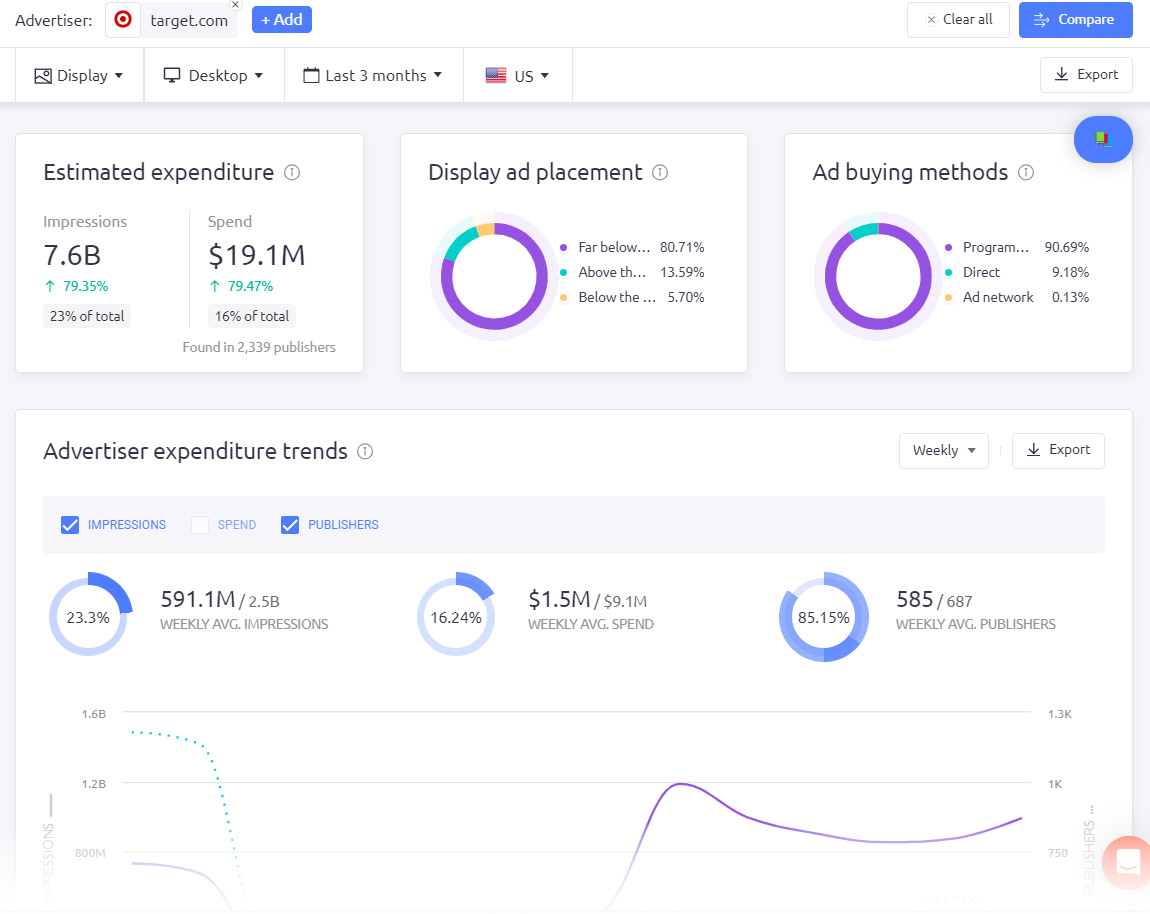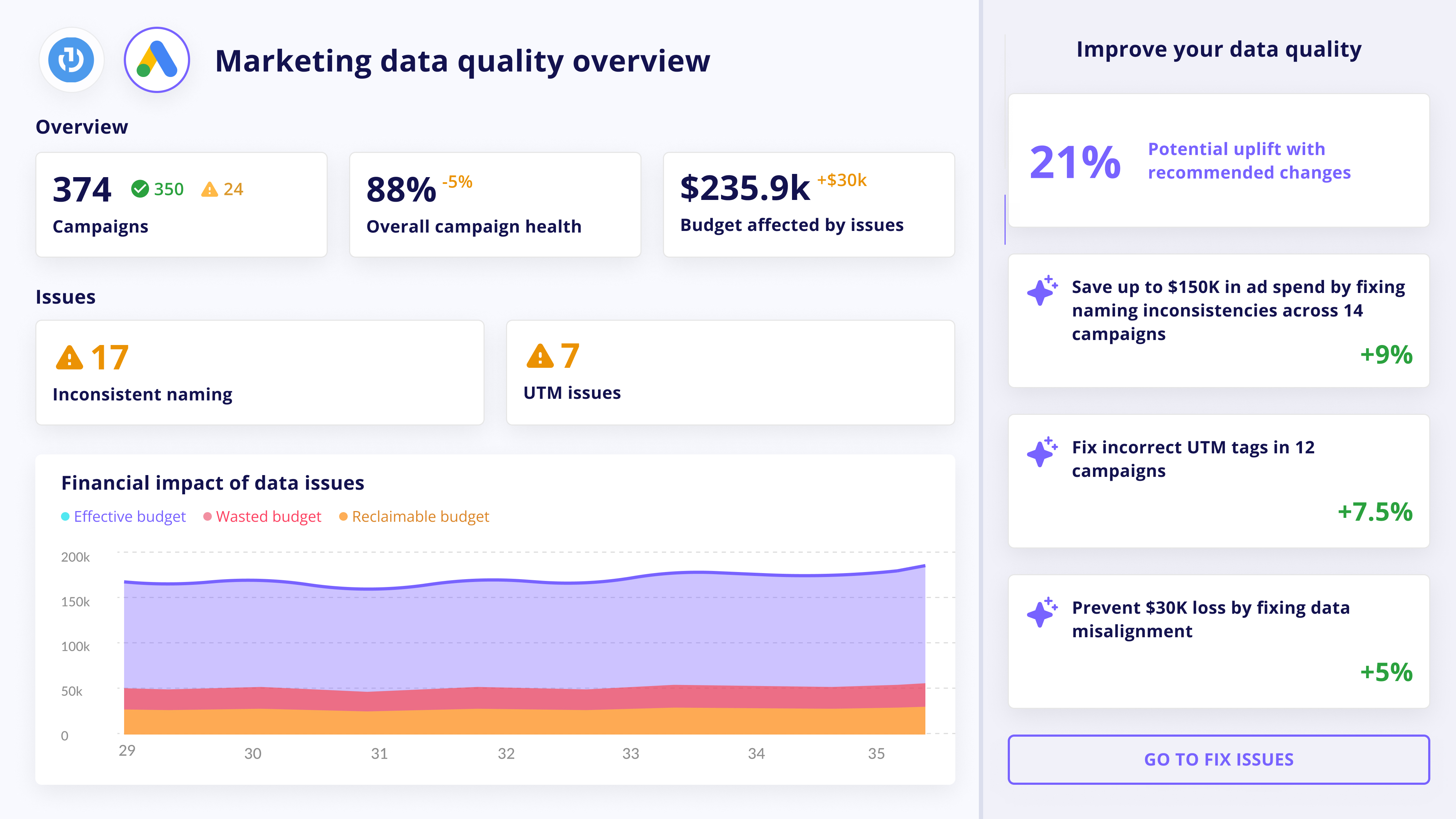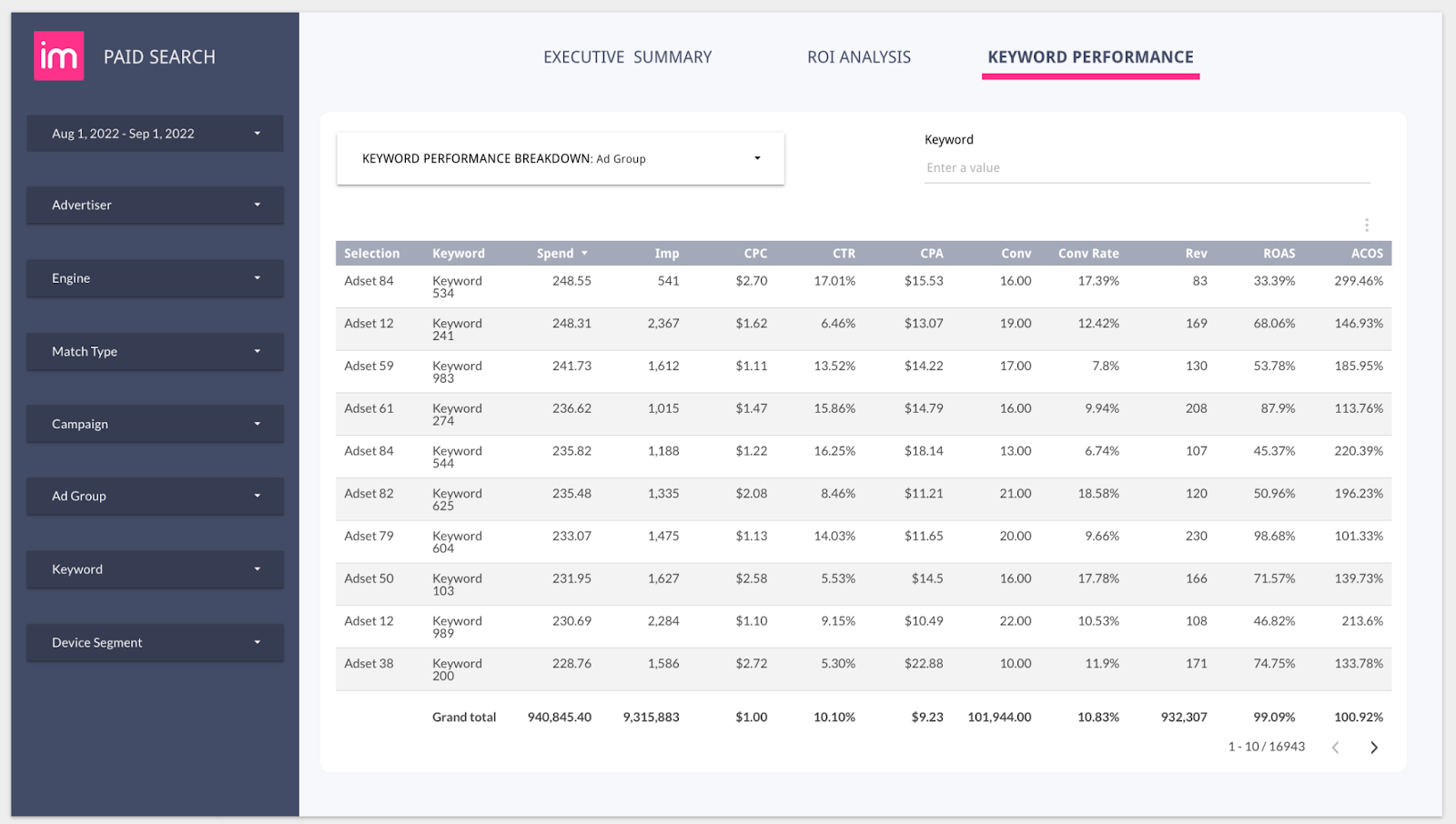The global digital advertising market is expanding at a compound annual growth rate (CAGR) of 14.7%. As advertising budgets grow, so does the need for efficiency.
With more competition and rising costs, the pressure is on marketers to not just attract traffic but to ensure every dollar spent contributes to the bottom line.
The question of how to increase ROAS becomes critical, pushing marketers to leverage advanced tools and new strategies to maintain profitability and stay competitive.
This guide will show 11 ways to improve PPC ROAS and maximize ad spend returns. At the end, you will have a comprehensive roadmap of ROAS calculation by which you can approach your advertising strategy in a different light.
What Is ROAS & How to Measure It?
ROAS stands for Return on Advertising Spend. It’s a key performance metric that measures the revenue generated for every dollar spent on advertising.
Here is the formula to calculate ROAS:
ROAS = (Revenue from Ads) / (Cost of Ads)
| Revenue Attributed to Ads | Total Ad Spend |
|---|---|
| Direct Sales Revenue: Revenue from purchases made by customers who clicked on your ad. This is the most straightforward component and is often tracked through e-commerce platforms or CRM systems. | Media Costs: The amount paid directly to platforms (like Google Ads, Facebook, LinkedIn, etc.) for ad placements. This includes CPC, CPM, CPA, and other customer acquisition costs, depending on the bidding strategy. |
| Attributed Sales: Sales that may not happen immediately after the ad interaction but are still influenced by it. Multi-touch attribution models help determine the revenue portion that should be attributed to your ads across different stages of the customer journey. | Creative Production Costs: Expenses related to the creation of ad content, including design, video production, copywriting, and other creative services. This can also include costs for A/B testing variations. |
| Recurring Revenue: For subscription-based models, this can include recurring revenue from customers acquired through ads, factoring in customer lifetime value (CLTV) where appropriate. | Agency or In-House Labor Costs: If you're using an agency, this would include fees paid to them for managing your ad campaigns. For in-house teams, it includes the cost of the team members' time dedicated to creating, managing, and optimizing campaigns. |
| Cross-Sell and Upsell Revenue: Revenue from existing customers who, after being exposed to an ad, make additional purchases beyond their initial transaction. | Technology and Tools: Costs for any software, analytics tools, or third-party services used to enhance or manage your ad campaigns, including attribution tools, ad management platforms, and tracking software. |
ROAS isn’t a static metric. It needs to be contextualized within the broader business goals and industry benchmarks. For instance, a ROAS of 5:1 might be considered excellent in one industry but suboptimal in another with higher profit margins.
By consistently analyzing ROAS in conjunction with other marketing metrics like customer acquisition cost and return on investment, marketers can fine-tune their strategies, optimize advertising budget allocations, and drive sustained profitability.
How to Calculate Breakeven ROAS
Start by calculating your profit margin, which is the amount of revenue that remains after accounting for all variable costs (like product costs and shipping). The formula for profit margin is:
Profit margin = (Revenue - Cost of goods sold (COGS) / Revenue × 100
For example, if your product sells for $100 and the COGS is $60, your profit margin is 40%.
The formula for breakeven ROAS is
Breakeven ROAS = 1 / Average Profit Margin %
Using the example above with a 40% profit margin, the Breakeven ROAS would be:
Breakeven ROAS = 1 / 0.4 = 2.5
This means you need to generate $2.50 in revenue for every $1 spent on advertising just to cover your costs.
Understanding breakeven ROAS is crucial for performance marketers because it sets the baseline for evaluating the effectiveness of your campaigns:
- If your actual ROAS is below the breakeven point, your campaigns are running at a loss, and adjustments are needed.
- If it’s above, your campaigns are profitable, and you can focus on scaling those efforts for greater returns.
How to Identify Good ROAS for Your Niche
Every niche has its own benchmarks, and marketers should use them to come up with a successful ad strategy. For example, the conversion rate for big-ticket items differs from low-priced ones.
ROAS is a controversial metric. There is no good or bad ROAS, as everyone has their own vision. Based on our experience, on Amazon, the average ROAS is only 3x or 300%. Consumer electronics have a ROAS of 9x while toys have 4.5x.
A good rule of thumb is a ROAS of 6x. It means that you are getting $6 back for every dollar you spend.
For example, if you spent $100 on ads, and your revenue is $600, your ROAS is 6. The thing is that this does not tell you if you are profitable. In case you earn $600 in total revenue, your total expense is $500, plus you spent $100 on ads, which means you’re not generating money.
Let’s look at some ways you can improve your ad spend numbers.
10 Ways to Increase ROAS
There are several ways to improve ROAS, but we want to focus on the best 10 approaches that work.
1. Observe your competitors' strategies
Your competitors use PPC campaigns to generate sales. Since you have the same intentions to make a sale, you can borrow some of their successful PPC campaign ideas.
While there is no way to see the ROAS from their ad groups, there is a way to find ad platforms where they advertise.
Use a tool like SimilarWeb to find out which ad networks your competitors are using. Even though SimilarWeb is not 100% accurate, it is a good starting point.
Here are more tools you can use:
- Facebook Ad Library
- Twitter Ads Transparency
- Semrush Display Advertising

What benefit does this give you?
First, it tells you how your strong competitors reach out to their target audience. Then, you can emulate their ad strategy or get ideas on making your ads more attractive and convincing for potential customers.
Second, you can see where they are spending most of their advertising budgets. For example, you are likely promoting your brand on Instagram, but your strong competitor spends most of its ad budget on Google ads.
From here, you can say that it is high time you also advertise on Google ads, not only on Instagram. After all, why would a strong brand advertise there if it is not working, right?
2. Leverage Campaign Data Governance to Solve Any Execution Inefficiencies
Sometimes, low ROAS isn’t due to competition but rather your own actions.
Poor targeting, inadequate exclusions, brand safety lapses, and other inefficiencies can drain the advertising budget on ads that fail to reach the intended audience or convert potential customers.
All these factors contribute to a wasted budget and missed opportunities to connect with the right audience segments, ultimately dragging down your ROAS.
What can be done? Implement a powerful Marketing Data Governance solution for campaign, brand and data compliance.

Marketing Data Governance helps continuously optimize ROAS through quality assurance across various aspects of campaign execution and real-time metric pacing.
Here's a breakdown of Marketing Data Governance features by campaign execution stages:
- Campaign setup governance at the pre-launch stage: Marketing Data Governance validates campaign setup, including targeting parameters, creative elements, budgets, and brand safety.
- Campaign performance governance at the in-flight stage: Marketing Data Governance monitors whether campaigns meet your performance expectations and benchmarks. For example, the platform monitors and notifies you when the average cost per click exceeds the benchmark, CTR drops, or line items exceed a certain number of clicks.
- Campaign analytics governance at the post-campaign stage: Marketing Data Governance validates the reliability of campaign data, including UTM naming conventions, data extraction statuses, and identifies any irregularities that could skew analytics results.
The platform alerts on any anomalies and rule breaks and displays the overall state of campaign governance on a clear dashboard for further review and analysis.
You can easily set campaign, operational, and business data rules by selecting pre-built rules from the library or building custom ones using AI Agent.
3. Keep Refining Your Keywords And Bidding Strategy
Keywords play a huge role in how customers make decisions.
For example, the keyword “flashlight for kids” will never make an adult hiking enthusiast buy it. The word “kid” connotes a toy—not for serious camping activities.
To increase ROAS, start continually analyzing the performance of your current keywords.

- Focus on keywords with exact match types that show strong performance in terms of CTR and conversion rate. Exact match keywords tend to deliver more qualified traffic; consider increasing bids on top performers to capture more high-intent traffic.
- Regularly analyze the performance of phrase and broad match keywords and use search query reports to identify which variations are driving valuable traffic. Use this insight to refine your match types or add relevant terms as exact match keywords to increase precision.
- Break down keyword performance by time of day and device type to identify patterns in user behavior. This targeted approach helps maximize the efficiency of your ad spend and improves overall ROAS.
- Equally important is refining your negative keyword list. By excluding terms that attract unqualified traffic, you can prevent your ads from being shown to users who are unlikely to convert, reducing wasted spend and improving your overall ROAS.
The other thing you must do is tweak your bidding strategy. There are many bidding strategies, but the most common ones include how much you will pay and how the advertising network will show your ads.
Here are some examples:
- Smart bidding – the ad network will optimize and automate your ad to help you achieve high conversions. The system chooses a target audience, and also uses the right format like banner ads.
- CPC bidding – you are paying per click of your ad; you can make an ad group for a specific demographic, and you will only pay if someone clicked your ad.
- CPM bidding – best for brand awareness, your ads are likely to find their way at the top of the blog page or the top of the search engine results.
If your goal is to improve your ROAS, the best bidding strategy is Smart Bidding. The algorithm of the ad network will determine if the person or user is likely to respond positively to your ad. If not, the machine will not show your ad group to the user.
4. Find The Right Audience And The Right Platform for Ads
Before the internet, most companies advertised on TV, print, and radio. They still do, but traditional non-digital advertising has shrunk. Anyone could see these ads, even those who do not belong to the advertiser’s target market.
Today, advertising platforms can show your ad to specific demographics of your choice. For example, you can show your ad to a female audience only or people in a particular state, city, or country.
It does not make sense to advertise on TikTok if you sell medicine for older adults. 60% of TikTok’s users are people below 34—your target market is not on this platform. Besides, it is a video platform for entertainment.
In this case, Meta should be your go-to advertising platform. Facebook has balanced demographics, and its users are likely to reach out to someone they know who will benefit from your product.
Each advertising platform has its benefits. The safest platforms to use are Google Ads, YouTube Ads, and Facebook if you are just starting.
If your brand is present on multiple platforms, use a marketing analytics platform to centralize all ad performance data in one place and analyze it side-by-side.
5. Lower the Cost to Develop Your Ad Campaigns
Instead of spending thousands on online advertising costs, divert that money into the advertising campaign expense.
One common mistake that we see too often is that eCommerce companies attempt to make TV-level ads. These advertising campaigns are expensive but may not always be worth it.
Instead of keeping up with these big brands' online advertisers, you would do better if you invested more in impressions, clicks, or advertising on various networks from your marketing budget.
Here are some tips on how you can lower the cost of developing ads:
- Repurpose high-performing content from other channels;
- Use images, not videos;
- Utilize automation tools that can dynamically create ads based on existing content or data feeds;
- Create a library of reusable design elements (e.g., buttons, logos, call-to-actions, fonts, color schemes) that can be mixed and matched to create new ads quickly;
- If you launch a video ad, keep it short;
- Before investing in the full production of a digital ad, test simple, low-cost versions (e.g., static images, basic animations) to gauge audience response;
- Use free music and video (no copyright).
Pro tip: Storytelling explainer videos ads tend to perform better than any other type of video content.
6. Optimize Ads for Appropriate Devices
There are thousands of device models. Desktop, laptop, tablet, mobile devices—you name it. Each device displays an app or browser differently.
If your ad is displayed inaccurately, the audience will not respond positively.
In addition, the ad would look unprofessional, affecting how people see your brand. Nothing will repel users more than a poor illustration of your brand.
Each platform has ideal sizes for images and videos. For example, Facebook has a page dedicated to its ideal ad sizes. The same thing goes for Google. You can then use a free tool to edit images online, so take the time to review these standards and comply with the rules.
It is now up to these platforms to make changes according to the user’s device. It is why for a single image ad, the platform may ask you for five variants of it—each variant works for specific devices.
Pro tip: The better you design your ads to make them suitable to these platforms, the more impressions they’ll gather. This is purely coming from experiences.
7. Make Your Landing Pages Look Like a Real Brand
Your landing page is your storefront. If it is not enticing enough, no one will buy.
The landing page makes a person decide whether or not they will spend—it is the final step to your ad creation process.
If a person stumbled across your landing page, it shows that you did well in your advertising efforts. Your ad performance is great, and the people who saw it are the right audience. As such, they clicked on it and found themselves on your landing page.
Here are some tips on how to make your landing page look like an authentic brand and improve user experience:
- Use professional hero banners;
- The copy must focus on benefits to the customer;
- Use a killer headline that sums up why a person must buy your product;
- Keep the landing page short and straightforward;
- Use images where appropriate;
- Add a video if necessary;
- Identify the pain and say that you are the solution.
A landing page is probably the most challenging kind of copy to write. It is the culmination of your marketing efforts. If you fail here, you not only lose the opportunity to make a sale, but you also lose a return on ad spend.
8. Create Better Content: Headlines, Videos, Sales Copy, CTA
Content is king. You will meet your target ROAS if you put the best content out there. From headlines to copy to testimonials—everything matters.
Here are some tips to help you write good ad copy with high ROAS:
- Headlines – keep them short and straight to the point; use words that arouse curiosity.
- Message – the message of your ad must contain two things: the problem and the solution. It must explain the pain point and that your products solve this pain.
- Testimonials – testimonials from users or buyers matter; it makes your product more credible and your ad more believable.
Videos are excellent for a return on ad spend, but they are also expensive. Use a video only if it is essential or already seeing a return on your ads.
9. Reduce Cart Abandonment by Leveraging CRO Strategies
Conversion rate optimization, or CRO, is a gamut of approaches to convince a person to make a purchase. However, to increase your ROAS, you must first increase your conversion rate. After all, the target ROAS is a factor of sales.
One thing you can do is reduce your cart abandonment. Users will typically add products to their cart out of impulse, and then leave your website without completing the purchase. It is a lost opportunity, but you can fix it.
Here are some tips on how to reduce cart abandonment:
- Be transparent on the purchase costs like shipping and handling
- Make the checkout process easy and short
- Add a thumbnail of the products on the checkout
- Add several payment methods
As you can see, there are potential reasons customers leave their shopping carts and abandon the purchase. If they find out they have to pay extra for handling, they will distrust you, thinking you are milking money off them.
Also, make sure that your payment processor and pages load fast. People typically leave a website if the page takes more than three seconds to load.
Another thing you can do is use an email software program that records the customer’s email address. It saves the email address and then sends an automated message to people who abandoned their shopping carts.
You can customize the message in this email for a specific ad campaign—make sure the consumers can reply to it so you can address their concerns.
As you go along, you will begin to realize that your customers have different reasons for not pursuing the purchase. So listen to them, and make room for improvements in your shop, products, and processes.
10. Choose the Highest Converting Ads And Platform to Rinse And Repeat
Not every social media platform is the ideal place to advertise. Each platform, be it Facebook, YouTube, or Google, has its demographics. Advertising on the wrong platform can be catastrophic.
For example, it does not make sense to advertise on Twitter if you’re in the cosmetics business. The best platform for this could be Instagram.
There are so many platforms out there, so let me provide a snapshot of the most used ones and when you should use them.
1. YouTube | Google Ads
With more than 2.3 billion users, YouTube is ideal for products you can demonstrate, such as a how-to video. It is also an excellent choice if you offer online courses or products where the consumers need guidance.
The search intent in YouTube and Google are highly specific and more targeted than social media sites which makes the conversions incredibly easy (if you target the right audience).
If you use the right keywords as a digital marketer, you can reach your target audience and get more ad clicks from people who are really looking for a product or service such as yours.
2 . Facebook
Facebook is a place where people build relationships. Use the platform to connect with your already existing customer base. It is a platform for building loyalty from your customers. Use it to release announcements, provide customer support, and do other after-sales activities.
Advertise on Facebook to capitalize on consumer relationships, such as if you have a new product that your existing customers may be interested in buying.
3. Instagram
The platform is home to many young people. It is an ideal social media site for tangible things, especially in the niche of beauty and physical health.
Instagram is an excellent advertising option if your product has something to do with food, cosmetics, food supplements, body-building devices—anything in which the results are visible.
Other marketing platforms like TikTok and Pinterest are not as effective. These platforms are home to very young people—those who love short videos or those who just want to have something to see online. However, their audiences are not exactly buyers.
Bonus Tip: Investigate Issues Unrelated To Your Ads
After implementing these strategies I recommended, you may also want to look at other things apart from your marketing strategy.
For example, is your product living up to the customer’s expectation?
If not, do not expect people to talk positively about your product. If your product reviews are bad, no one will buy what you sell, even if they clicked on your PPC campaign ad.
Another thing you must consider is your after-sales services. It refers to the customer support you offer after buying your item. Some examples of this service are shipping and tracking, repair, warranty, returns, refunds, technical support, etc.
ROAS is a better measurement than click-through rate. CTR only tells you the number of clicks per impression, but it does not translate into money.
While conversion rate is also a good metric, it does not show you a good picture of what is happening on a dollar-by-dollar basis—but ROAS does.
.png)



.png)
